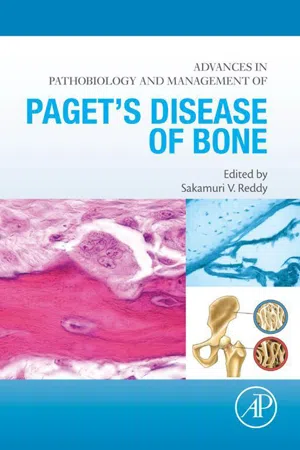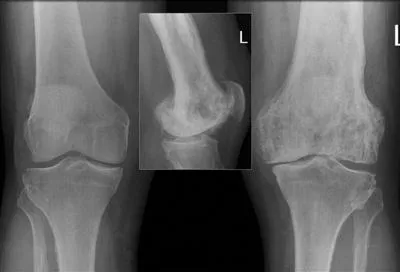
This is a test
- 158 pages
- English
- ePUB (mobile friendly)
- Available on iOS & Android
eBook - ePub
Advances in Pathobiology and Management of Paget's Disease of Bone
Book details
Book preview
Table of contents
Citations
About This Book
Advances in Pathobiology and Management of Paget's Disease of Bone presents an essential collection of up-to-date knowledge about the pathophysiology, genetics, and treatment of Paget's disease. It covers the comprehensive information related to clinical perspectives, epidemiology, genetics, environmental factors such as viral etiology, molecular abnormalities, complications such as osteosarcoma, and current and future treatment for Paget's disease. This book serves as a useful volume for basic scientists, graduate students, and practicing clinicians in understanding the pathobiology, etiology, and treatment of this disease.
- Discusses the current research of the nature of Paget's disease and its response to the latest treatments which are seminal in the management of this disease
- Helps users quickly assess the very latest details on the diverse scientific and clinical aspects of Paget's disease, as opposed to searching through multiple journal articles in the literature
- Presents work from featured leaders in Paget's disease around the globe
- Serves as a useful volume for basic scientists, graduate students, and practicing clinicians in understanding the pathobiology, etiology, and treatment of this disease
Frequently asked questions
At the moment all of our mobile-responsive ePub books are available to download via the app. Most of our PDFs are also available to download and we're working on making the final remaining ones downloadable now. Learn more here.
Both plans give you full access to the library and all of Perlego’s features. The only differences are the price and subscription period: With the annual plan you’ll save around 30% compared to 12 months on the monthly plan.
We are an online textbook subscription service, where you can get access to an entire online library for less than the price of a single book per month. With over 1 million books across 1000+ topics, we’ve got you covered! Learn more here.
Look out for the read-aloud symbol on your next book to see if you can listen to it. The read-aloud tool reads text aloud for you, highlighting the text as it is being read. You can pause it, speed it up and slow it down. Learn more here.
Yes, you can access Advances in Pathobiology and Management of Paget's Disease of Bone by Sakamuri V. Reddy in PDF and/or ePUB format, as well as other popular books in Medicine & Orthopedics. We have over one million books available in our catalogue for you to explore.
Information
Topic
MedicineSubtopic
OrthopedicsChapter 1
Clinical Perspectives of Paget’s Disease of Bone
Tim Cundy, Department of Medicine, Faculty of Medical & Health Sciences, University of Auckland, Auckland, New Zealand
Abstract
Paget’s disease is a focal disorder of dysregulated bone turnover that was formerly common amongst older people, particularly those of western and southern European descent. In recent decades the prevalence has apparently fallen and newly presenting cases are older and have fewer bones involved. This suggests that in addition to the known genetic factors, there is an important (as yet unidentified) environmental factor in its etiology. Many patients with Paget’s disease are asymptomatic but well recognized complications include bone pain, deformity, fracture, and secondary osteoarthritis. Paget’s disease is usually diagnosed from its characteristic radiographic appearance. Bone scintigraphy is the best method of determining which bones are involved. Bone turnover markers are variably raised depending primarily on the extent of disease.
Keywords
Osteitis deformans; osteosarcoma; natural history; sequestosome 1; clinical presentation; bone turnover markers; complications-acute; procollagen-1 N-propeptide; complications-chronic; alkaline phosphatase; radiographic appearances; assessment of severity; skeletal scintigraphy; differential diagnosis; prevalence; environmental factors; epidemiology; histology; secular change; archaeology
Introduction
In London in November 1876 the English surgeon Sir James Paget presented to the Medical and Chirurgical Society the case of a patient that he had looked after for almost 20 years, who had an unusual deforming bone disease. He noted similar cases from the literature (the first from 1801) and suggested they were the same disorder; he published a second series of cases in 1882.
Paget was particularly struck by the enlargement of affected bones and reasoned that “only tumour, hypertrophy or chronic inflammation” could produce this effect. Thinking of parallels with chronic osteomyelitis he felt the likely pathology was “chronic inflammation” and suggested the name osteitis deformans. However, even by the late 19th century the eponymous name, Paget’s disease, was already widely used.
We now recognize Paget’s disease of bone as a focal disorder of dysregulated bone turnover that is common amongst older people, particularly those of western European descent. Although there have been significant advances in understanding the epidemiology, genetics, and molecular biology of Paget’s disease, we do not yet have a complete understanding of its causes and natural history. In this chapter we examine the pathology, epidemiology, and clinical features of the disorder.
Two excellent monographs on Paget’s disease are those by Ronnie Hamdy and John Kanis [1,2].
Natural History
There are still gaps in our knowledge of the natural history of Paget’s disease. It is a lifelong disorder presenting primarily in middle-aged and older people. It arises apparently simultaneously in one or more skeletal sites. In long bones it originates in the proximal epiphysis or metaphysis [3].
A study of 100 patients who had repeated skeletal scintiscans an average 5½ years after an initial diagnostic scan showed that none had developed new lesions [4], so the disease probably remains restricted to the bones where it originally arose. An exception to this rule is that the disease can be transferred to new skeletal sites by the use of pagetic bone for surgical bone grafting [5].
Once established, the pagetic lesion expands in size. In long bones a typical “lytic wedge,” reflecting active osteoclastic resorption, can often be seen at the advancing edge—and is a sign of early disease (Fig. 1.1). In the skull this appearance is known as “osteoporosis circumscripta.” The rate of progression of the disease through the skull or long bones, as estimated from serial radiographs, is in the order of 8 mm/year.

Paget’s disease has characteristic radiographic appearances of varying degrees of lysis and sclerosis that reflect the histological findings of increases in both bone formation and resorption. Disease activity as assessed by plasma alkaline phosphatase (ALP) activity tends to increase slowly over time; this may reflect the expansion of lesion size, or change in disease activity. In many patients ALP activity eventually reaches a plateau with relatively small random fluctuations. An “end-stage” disease has been described in which bone turnover declines leaving dense sclerotic bone with minimal bone turnover, but it is difficult to find convincing documentation of this happening spontaneously (see Box 1.1).
Clinical Features and Complications
In many patients Paget’s disease is asymptomatic, and can remain so throughout life, but others may have symptoms for long periods before the disease is recognized (Box 1.2).
Bone pain is common—typically it is worse at rest (often at night or early after rising) and is relieved by movement. Pain from osteoarthritis that is secondary to juxta-articular Paget’s disease is also common. Other symptoms caused by complications include pathological fracture (which occurs most commonly in lytic disease in long bones), painful fissure fractures, bone enlargement, and deformity. Paget’s disease in the skull can cause deafness (usually from involvement of the otic capsule) and increasing hat size (Figs. 1.2–1.7). Very rarely Paget’s disease of the spine can cause an acute myelopathy (most commonly due to a vascular “steal” rather than cord compression). Any bone in the skeleton can be involved, but some more commonly than others (Table 1.1).

Table of contents
- Cover image
- Title page
- Table of Contents
- Copyright
- List of Contributors
- About the Editor
- Preface
- Chapter 1. Clinical Perspectives of Paget’s Disease of Bone
- Chapter 2. Viral Etiology of Paget’s Disease of Bone
- Chapter 3. Genetics of Paget’s Disease of Bone
- Chapter 4. Developmental Aspects of Pagetic Osteoclasts
- Chapter 5. Mutant SQSTM1/p62 Signaling in Paget’s Disease of Bone
- Chapter 6. Early Onset Pagetic Disorders: Implications for Late-Onset Paget’s Disease of Bone
- Chapter 7. Osteosarcoma in Paget’s Disease of Bone
- Chapter 8. Paget’s Disease of Bone: Prognosis and Complications
- Chapter 9. Treatment of Paget’s Disease of Bone
- Index